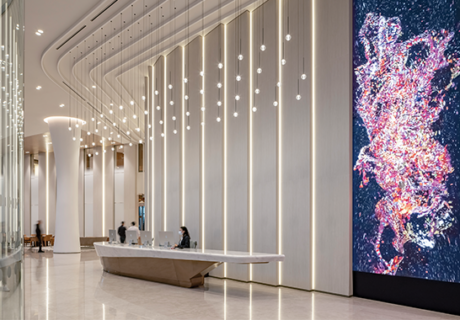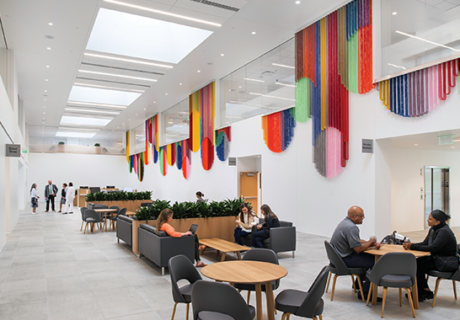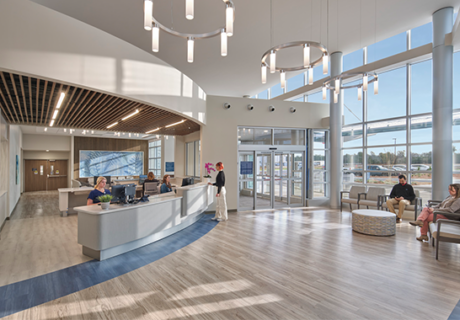Piece By Piece: Rebuilding Martin Luther King Jr. Community Hospital
Southeast General Hospital opened in South Los Angeles in the aftermath of the 1965 Watts Riots. For decades, the facility, which was renamed Martin Luther King Jr. – Harbor Hospital, was one of the few hospitals serving the community’s poorest residents. It had a big presence, too, housing more than 450 beds, an active trauma center, and a nearly 40-acre campus.
However, after years of health and safety violations caused the hospital to lose its accreditation from The Joint Commission and certification from the Centers for Medicare and Medicaid, the safety-net hospital was forced to close in 2007. A campus outpatient center remained open, but the lack of emergency and inpatient services left a big hole in the community. It also forced area residents, many of whom rely on public transportation, to travel long distances to access comprehensive healthcare services elsewhere.
In 2010 the county, community leaders, and residents began looking for funding to bring a new hospital back to the area, and five years later the Martin Luther King Jr. Community Hospital opened, the final piece of an overall campus revitalization that included a new outpatient clinic, campus entrance, and renovated inpatient tower, as well as a new chapter for the community.
Putting it together
From the onset of the project, the county wanted to do things differently to avoid past mistakes. “The design was shaped by so many forces,” says Kirk Rose, principal and healthcare practice leader at HMC Architects (Los Angeles), which served as the design, scoping architect, and interior design firm on the $285 million hospital project.
One of the biggest changes was a new public-private partnership established between the county and the Martin Luther King Jr. Los Angeles Healthcare Corp., an independent nonprofit organization that was formed to operate the new hospital. Through this arrangement, the county owns the healthcare campus and the corporation leases the 280,000-square-foot hospital, which was located in one of the original hospital buildings after it received an extensive renovation. Additionally, the county owns and operates the 137,500-square-foot outpatient clinic, which was constructed on the campus and opened in 2014.
A number of shared service agreements were set up between the two buildings to reduce operating costs and maximize efficiencies, creating “a whole matrix of how they service each other,” Rose says. For example, the existing central plant on campus was renovated and upgraded to serve both the inpatient and outpatient buildings.
The county also set out to avoid duplicating services by creating one central sterile department. For inpatient use, California’s Office of Statewide Health Planning and Development (OSHPD) mandates the department be in the hospital structure, so designers coordinated the surgery levels in each building with a bridge between them, and each morning case carts for the day’s surgeries at the outpatient center are processed at the hospital and taken across the bridge into that building’s sterile surgery suite. A flash sterilizer is also on hand in case an instrument is dropped.
“It’s very cost effective,” Rose says, noting that the strategy saved millions of dollars in construction costs and duplicated equipment in the outpatient facility.
Another influence on the design of the new hospital was the range of services provided. “Before they hired us, the county studied the demand in the community and found it wasn’t the same as in the past,” Rose says.
For one, there were other facilities in the area providing trauma services, which meant the new hospital could be smaller with 131 licensed beds and a more “meat-and-potatoes” service mix, including imaging, emergency services, and general surgery. Second, a lot of young families were living in the area, driving up the need for a larger birthing program than before.
In fact, after construction was completed and prior to the facility opening, the operator went back to the design team to reconfigure the third floor to add another C-section room and two more labor and delivery rooms. “They believed there was more opportunity to serve the community with labor and delivery than was originally programmed,” Rose says.
The former hospital buildings also played a role in shaping the project. The original 1970s hospital structure wasn’t up to current building code, but an addition—constructed in 1995 with an emergency department, imaging, and three floors of shelled office space—did meet California’s seismic requirements and had enough room to serve as the inpatient tower.
Its first-floor ED was subsequently renovated as a non-trauma unit with a new fast-track component; labor and delivery, five ORs, and private patient rooms were located on the upper floors. The project realized further cost savings by reusing the site’s 12-bay loading dock.
One element that couldn’t be reused was the hospital entrance, since it was cost prohibitive to renovate the original 1970s building, which is still standing while the county discusses future use options. Constructing a new entry required looking to the back of the campus where there was enough space between the renovated hospital tower and the new outpatient facility to build an ancillary building that would serve as the main entrance.
The 20,000-square-foot structure also houses registration, a gift shop, chapel, cafeteria, and administrative offices and is accessible by a new entry drive with drop-off loop that was also constructed as part of the new campus entrance.
Aiming for world-class
With a new campus setting in the works, the project team turned its attention to transforming the interior of the former addition into a new inpatient tower. Rose says the county gave HMC the directive to deliver a building that would be at home equally in Beverly Hills as it would in South L.A.
“They want [the community] to feel like they’re getting world-class healthcare by the design of the building,” he says.
Recognizing that a lot of area residents rely on the ED for their primary care needs, the team sought to improve operations and help drive down healthcare costs by rerouting care to the most appropriate setting. A new lobby and triage station are placed near the ED entrance so staff can immediately assess patients and direct non-urgent cases across campus to the outpatient center, while more acute cases are sent to one of eight fast-track rooms or 21 high-acuity treatment bays.
Consulting firm Northern Lights (Phoenix) was hired to run a simulation model to fine-tune the layout and maximize throughput. One of the changes that resulted from the process, says George Vangelatos, design principal at HMC Architects, was moving fast track to the front of the unit and relocating the staff door between the ED and fast track areas.
“The idea was that there could be fast circulation from triage, into fast track, and then back to the waiting room, keeping lower acuity patients out of the ED proper,” he says.
One problem was that the renovated addition had 12-foot six-inch height floors, instead of the desired 15 feet for the new patient floors. The solution to the lower ceiling heights was to install fan coil units in the patient bathrooms to provide local heating and cooling in each room and reduce the size of the duct work that would otherwise be needed on the patient floors.
For the interior design, Vangelatos says the goal was to balance material and color choices in a way that would create a timeless building that was easy to maintain and non-institutional. The team invested in high-quality materials in strategic or high-traffic areas, such as
terrazzo flooring in the lobby and public spaces on the first floor, solid-surface counters at the nurses’ stations, and heavy-duty doors throughout the facility. Neutral colors were chosen for the more permanent materials, with pops of color introduced in areas that would be updated more frequently, such as the carpeting, upholstery, and graphics.
The county was also committed to infusing the healthcare facility with art by investing $1 million in public art projects. A sculpture, “Pieces Together” by Lawrence Argent, is located in the entry roundabout to the hospital and looks like a jigsaw puzzle piece composed of different pairs of lips, representing the voices of the community.
In the central courtyard, “Azul Healing Garden” by Dan Corson creates a respite space using 33 tons of blue glass mulch, plants with blue-tinged leaves, and blue twinkling solar lights in the walkway and planting beds.
A fresh look was also delivered on the exterior using silver metal panels, blue-green glass, and green slate cladding to help unify the buildings and campus.
“One of the strongest features is the canopy element, which is a steel and glass structure that connects the two main entrances of the outpatient and inpatient buildings,” Vangelatos says. “It creates a nice glass ribbon that visually and functionally gives you that connection.”
Originally, the county didn’t budget to reclad the renovated inpatient tower, which had a precast concrete and gray glass façade. “At first they asked if we could put some metal panels and blue-green glass on the one side that faces the front,” Rose says. “Then, after the design-builder took the project over, they found more money and [the county] said we could do all four sides. They very much wanted it to appear to be a whole new campus.”
Anne DiNardo is senior editor of Healthcare Design. She can be reached at anne.dinardo@emeraldexpo.com.
For a source list relating to this project, see “Martin Luther King Jr. Community Hospital: Project Breakdown.”




